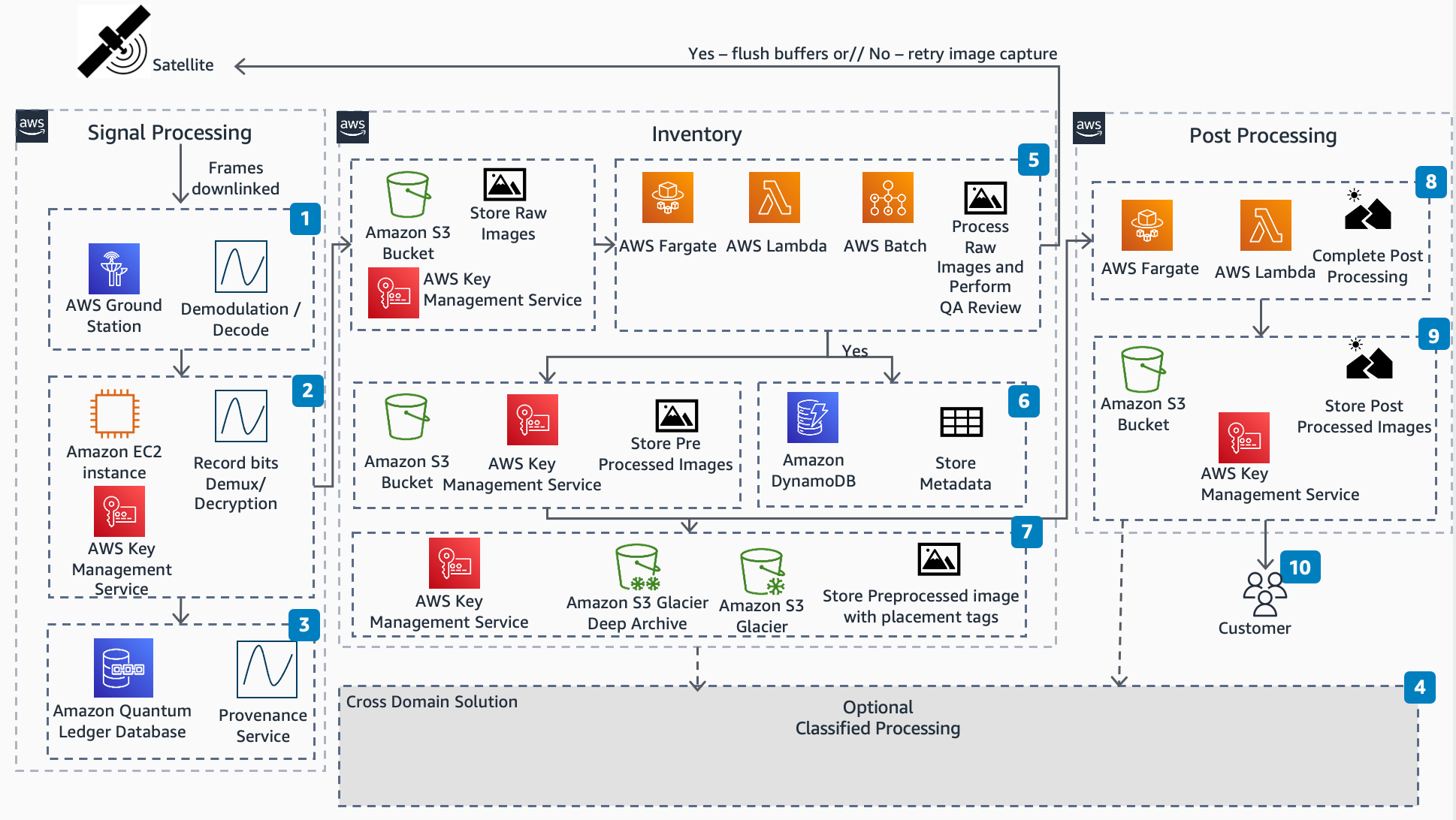Electro-Optical Imagery Reference Architecture
Publication date: May 12, 2021 (Diagram history)
This architecture enables you to process electro-optical imagery on AWS.
Electro-Optical Imagery Reference Architecture

-
Demodulate and Decode: Extract baseband waveform from modulated carrier; remove forward error correction.
-
Convert into raw sensor data: Decommutate signal frames; decrypt data .
-
Process Raw Images: Process Raw Images and Perform QA Review
QA Review: Confirm Images are sufficient for processing
AWS Batch: Run multiple jobs in parallel
AWS Fargate and AWS Lambda:
Sensor Correction: Apply corrections for optical distortions
Orthorectify: Sensor perspective
Georeference: Apply image to spatial grid and assign known coordinate system
Generate Thumbnails: Create post-processed thumbnails for customer purchase
-
Store metadata: Store information on latitude/longitude collection, region collection, time and date of retrieval .
-
Storage: Store preprocessed images in a variety of Amazon S3 services by balancing cost savings and time of retrieval.
-
Post Processing and Analysis: Complete imagery processing.
Feature Extraction: Identify features in images (such as ships)
Naming/Tagging of Features: Tag features by name/identification system
Time Series Creation: Tag images to sort
-
Storage and Dissemination: Final storage of images and analytics for end customer.
-
Customer Delivery: Deliver final images to end customers
Electro-Optical Imagery Reference Architecture (Classified Processing)

-
Demodulate and Decode: Extract baseband waveform from modulated carrier; remove forward error correction.
-
Convert into raw sensor data: Decommutate signal frames; decrypt data .
-
Immutable transaction log: Cryptographically establish provenance and fidelity .
-
Optional Classified Processing: Throughout the image processing, move data to the appropriate regions for classified processing.
-
Process Raw Images: Process Raw Images and Perform QA Review
QA Review: Confirm Images are sufficient for processing
AWS Batch: Run multiple jobs in parallel
AWS Fargate and AWS Lambda:
Sensor Correction: Apply corrections for optical distortions
Orthorectify: Sensor perspective
Georeference: Apply image to spatial grid and assign known coordinate system
Generate Thumbnails: Create post-processed thumbnails for customer purchase
-
Store metadata: Store information on latitude/longitude collection, region collection, time and date of retrieval .
-
Storage: Store preprocessed images in a variety of Amazon S3 services by balancing cost savings and time of retrieval.
-
Post Processing and Analysis: Complete imagery processing.
Feature Extraction: Identify features in images (such as ships)
Naming/Tagging of Features: Tag features by name/identification system
Time Series Creation: Tag images to sort
-
Storage and Dissemination: Final storage of images and analytics for end customer.
-
Customer Delivery: Deliver final images to end customers
Download editable diagram
To customize this reference architecture diagram based on your business needs, download the ZIP file which contains an editable PowerPoint.
Create a free AWS account
Sign up for an AWS account. New accounts include 12 months of AWS Free Tier
Further reading
For additional information, refer to
Diagram history
To be notified about updates to this reference architecture diagram, subscribe to the RSS feed.
| Change | Description | Date |
|---|---|---|
Initial publication | Reference architecture diagram first published. | May 12, 2021 |
Note
To subscribe to RSS updates, you must have an RSS plugin enabled for the browser you are using.
